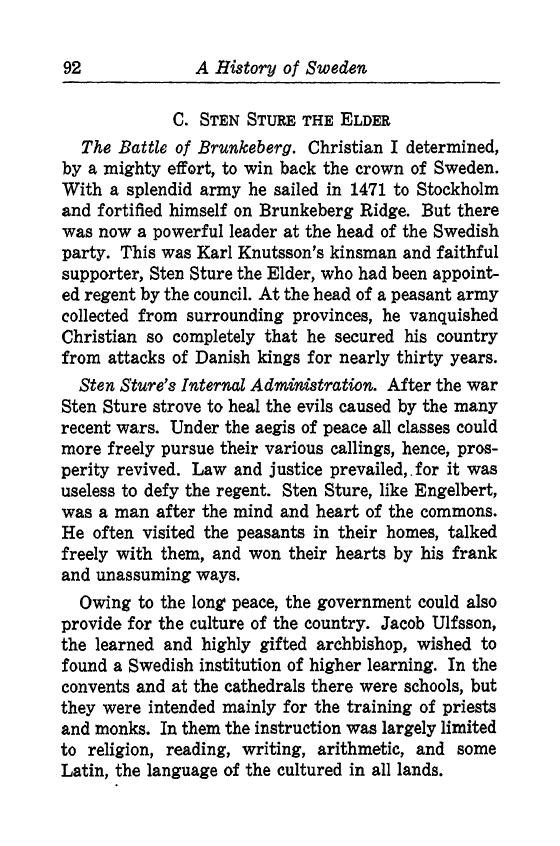
Full resolution (TIFF) - On this page / på denna sida - VI. Period of the Union, 1389–1531 - C. Sten Sture the Elder

<< prev. page << föreg. sida << >> nästa sida >> next page >>
Below is the raw OCR text
from the above scanned image.
Do you see an error? Proofread the page now!
Här nedan syns maskintolkade texten från faksimilbilden ovan.
Ser du något fel? Korrekturläs sidan nu!
This page has never been proofread. / Denna sida har aldrig korrekturlästs.
92 A History of Sweden
C. STEN STURE THE ELDER
The Battle of Brunkeberg. Christian I determined,
by a mighty effort, to win back the crown of Sweden.
With a splendid army he sailed in 1471 to Stockholm
and fortified himself on Brunkeberg Ridge. But there
was now a powerful leader at the head of the Swedish
party. This was Karl Knutsson’s kinsman and faithful
supporter, Sten Sture the Elder, who had been appoint-
ed regent by the council. At the head of a peasant army
collected from surrounding provinces, he vanquished
Christian so completely that he secured his country
from attacks of Danish kings for nearly thirty years.
Sten Sture’s Internal Administration. After the war
Sten Sture strove to heal the evils caused by the many
recent wars. Under the aegis of peace all classes could
more freely pursue their various callings, hence, pros-
perity revived. Law and justice prevailed,. for it was
useless to defy the regent. Sten Sture, like Engelbert,
was a man after the mind and heart of the commons.
He often visited the peasants in their homes, talked
freely with them, and won their hearts by his frank
and unassuming ways.
Owing to the long* peace, the government could also
provide for the culture of the country. Jacob Ulfsson,
the learned and highly gifted archbishop, wished to
found a Swedish institution of higher learning. In the
convents and at the cathedrals there were schools, but
they were intended mainly for the training of priests
and monks. In them the instruction was largely limited
to religion, reading, writing, arithmetic, and some
Latin, the language of the cultured in all lands.
<< prev. page << föreg. sida << >> nästa sida >> next page >>